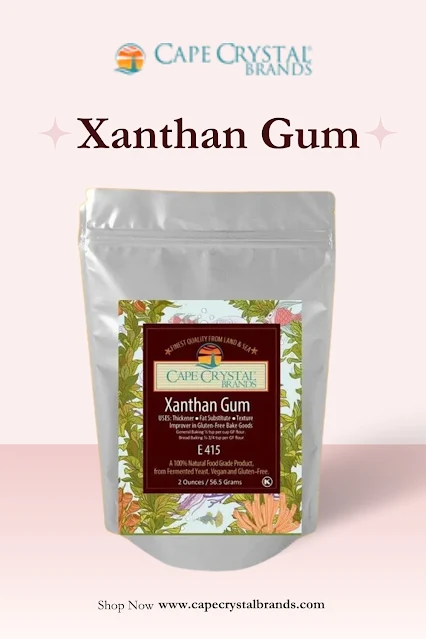Featured
- Get link
- X
- Other Apps
What is Xanthan Gum? A Complete Guide
Have you ever checked the ingredient list on a food label and spotted "xanthan gum"? If you’ve ever wondered what it is and why it’s used, you’re in the right place. Xanthan gum is a popular food additive with unique properties that improve texture, stability, and consistency in many products. In this guide, we’ll break down everything you need to know about xanthan gum in a simple, user-friendly way.
What is Xanthan Gum?
What is xanthan gum? xanthan gum is a natural food additive commonly used as a thickener, stabilizer, and emulsifier in various food and non-food products. It is made by fermenting sugar with bacteria (Xanthomonas campestris), which creates a gel-like substance. This substance is then dried and ground into a fine powder—what we know as xanthan gum.
Once mixed with liquid, xanthan gum turns into a thick, sticky solution, making it incredibly useful in food production, cosmetics, and even industrial applications.
Why is Xanthan Gum Used?
Xanthan gum is a versatile ingredient that enhances the quality of many products. Here’s why it’s commonly used:
-
Thickening Agent – It helps give sauces, soups, and dressings a smooth, creamy texture.
-
Stabilizer – Prevents ingredients from separating in products like salad dressings and ice cream.
-
Gluten-Free Alternative – A must-have ingredient in gluten-free baking to provide elasticity and structure.
-
Improves Texture – Makes foods like yogurt, mayonnaise, and even toothpaste smoother.
-
Works in Hot & Cold Liquids – Unlike some thickeners, xanthan gum works at any temperature.
How is Xanthan Gum Made?
The production of xanthan gum involves a natural fermentation process. Here’s how it works:
-
Fermentation – Sugar (from corn, soy, or wheat) is fermented using the Xanthomonas campestris bacteria.
-
Gel Formation – The bacteria produce a thick, gooey substance.
-
Drying & Powdering – The gel is dried and turned into a fine powder.
-
Packaging – The powder is packaged and ready to be used in various industries.
Although it's derived from natural sources, xanthan gum undergoes some processing before being added to products.
Is Xanthan Gum Safe?
Yes, xanthan gum is considered safe for consumption by health authorities like the FDA and EFSA. It is generally well-tolerated, but in large amounts, it may cause mild digestive issues like bloating or gas.
Who Should Be Cautious?
-
People with severe corn, soy, or wheat allergies (since it’s derived from these sources).
-
Those with digestive disorders (as it can act as a mild laxative in high doses).
For most people, small amounts of xanthan gum in food are completely safe and even beneficial for texture and consistency.
Where is Xanthan Gum Used?
Xanthan gum is widely used in:
-
Food Products – Gluten-free baked goods, sauces, salad dressings, dairy products, soups, and ice creams.
-
Cosmetics – Found in lotions, shampoos, and toothpaste to maintain texture and thickness.
-
Industrial Uses – Used in oil drilling, paints, and adhesives to improve consistency.
Because it’s such an effective thickener and stabilizer, it has a wide range of applications.
How to Use Xanthan Gum in Cooking & Baking
If you’re into gluten-free baking, xanthan gum is a must-have. Here’s how to use it:
For Baking
-
Use ½ to 1 teaspoon per cup of flour to help doughs and batters stick together.
For Sauces & Soups
-
Mix a small pinch into soups, gravies, or salad dressings to prevent separation and improve texture.
Pro Tip: Always sprinkle xanthan gum into liquid slowly while whisking to prevent clumps.
Is Xanthan Gum Vegan & Gluten-Free?
Yes, xanthan gum is 100 percent vegan and gluten-free. Since it’s made from fermented sugars and bacteria, it contains no animal products. That’s why it’s commonly used in vegan and gluten-free recipes.
Final Thoughts
Xanthan gum is a powerful yet simple ingredient that improves food texture, stabilizes recipes, and enhances gluten-free baking. It’s widely used in the food industry and is completely safe for most people. Whether you’re a home baker or just curious about food science, understanding xanthan gum helps you make better choices in the kitchen.
Popular Posts
Discover the Magic of Plant-Based Gelling Agents in Modern Cooking
- Get link
- X
- Other Apps
Reasons for the Growing Popularity of Sunflower Lecithin in the Food Industry
- Get link
- X
- Other Apps



Comments
Post a Comment